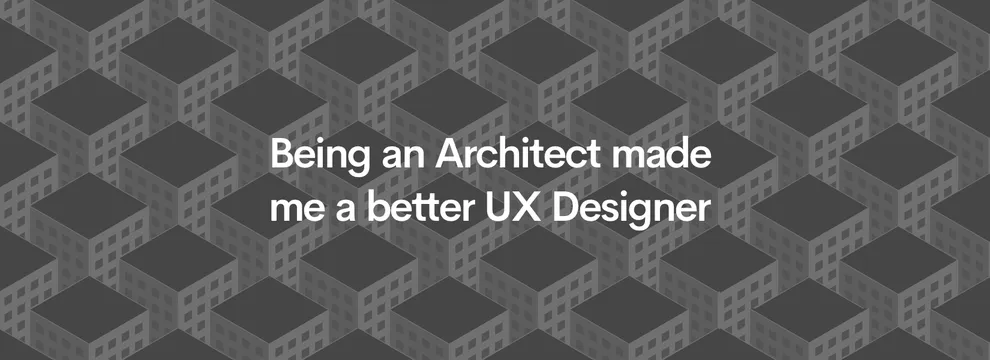A background in architecture molded me well to fit the role of a User Experience (UX) Designer. There is no definite route to become a UX Designer but I would like to believe that Architecture is the best route. It shaped my mind and gave it direction to think with empathy and communicate with design. I’ve always loved working with clients/users and having ‘user’ in the title of my job role is just an added plus. This is something I love talking about and my first attempt at penning it down.
To start with, let’s just look at the definition of an Architect and a User Experience (UX) Designer,
- Architect (noun)
A person who designs buildings and in many cases also supervises their construction. He provides services in connection with the design of buildings and the space within the site surrounding the buildings, that have as their principal purpose human occupancy or use.
- UX Designer (noun)
A person who enhances the customer’s satisfaction and loyalty by improving the usability, ease of use, and pleasure provided in the interaction between the customer and the product.
Many have written about the similarities and many have justified the shift from Architecture to UX Design. I would not call it a shift in field, in my story Architecture was my fuel to reach the UX destination. Needless to say, UX is not Architecture’s only destination nor is Architecture UX’s only fuel. I want to list just 5 points where parallels can be drawn between both the disciplines.
##Perspective
As an architect I was trained to constantly design for the client or the user/inhabitants of a space. Every aspect of design is based on the needs, wants, likes and dislikes of the user. This level of inclination towards the user’s interest sure does add brownie points in the UX discipline.
##Quick Iteration and Validation
In architectural projects, we have client presentations at healthy intervals to keep the clients in loop about the design direction and progress. This also helps in getting feedback from the users and iterating before the actual construction begins. A very similar approach is taken in the UX process as well. Although, UX design beats architecture in the iteration and validation space because the end product can be directly tested with the users and also quickly iterated based on feedback. Aren’t MVPs disguised promises of a better product?! 😉
##Form follows Function
The famous quote ‘Form follows Function’ by the American architect Louis Sullivan is loosely used in many instances, but can it be used in the world of the web? Most definitely YES!! I loved it as an architect and love it even more as a UX Designer. In terms of architecture, what it means is that the form of the space depends on the function that it performs, similarly in the world of the web it means that aesthetic requirements comes after the functional requirements. A beautiful product comes not from ornamentation but from purity of function.
##Navigation
An architectural project is started with something called a bubble diagram which is essentially making every space requirement into a bubble and placing it next to each other based on prioritizing proximities. This helps in finalizing the navigation around the space. This practice works fantastically in the web world. It allowed me to comfortably think about site maps and user flow. Making wireframes to simplify navigation through the site is my favorite part of the UX design process. The similarity in the approach to tackle navigation is very interesting considering the vast difference in mediums.
##Seeing the bigger picture
Architects are trained to think of context. We are taught to think about how the buildings we design relate to its surroundings. Does it stick out like a sore thumb or does it feel native to it’s surroundings? Thinking like an architect made me a better user experience designer. My mind always thinks about how a good experience fits with the context of the product and how it can influence a user’s future actions. Personally I feel like this capacity to think as a whole or to look at the bigger picture is a powerful boon which is not duly appreciated enough by the end users.
Parallels between architecture and user experience design in undeniable and the thought process is indistinguishable. Giving the users what they need is what both the disciplines go for and what we strive to achieve everyday at Skcript .
Subscribe to our newsletter
Get the latest updates from our team delivered directly to your inbox.
Related Posts
11 things I learned as Designer in 11 months
The trials and triumphs of a self-taught designer. This might even be your story too - why don't you read and find out.
19 Cool Figma Plugins you need to know
Figma plugins are making our lives as designers easier than ever. Here is a list of 19 cool Figma Plugins you need to know to get design superpowers.
22 design quotes from experts you need to read when you're feeling stuck
Does this question "How can I make this design great" keep you up at night? Looks like it's time for some motivation. Here is a curated list of quotes from great design experts who wanted to share their wisdom with their designer friends. 22 thought-provoking ideas you don't wanna miss.

